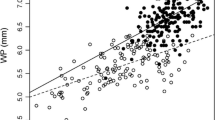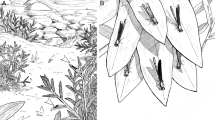Abstract
Males of the damselfly,Mnais pruinosa costalis, exhibit wing color dimorphism: one form has orange wings, and the other hyaline wings which resemble female wings. The former is usually territorial and the latter uses sneaky mate securing tactics. When orange-winged males failed to establish territory, they became floaters that day. Hyaline-winged males perched around their territories and often, formed in tandem without any apparent courtship behavior when they found females. Their copulation frequency was higher and copulation duration longer than those of territorial males. A few females oviposited without remating. Total oviposition duration of females with which a hyaline-winged male mated was more than 32 min per male on average in a day Females that copulated with hyaline-winged males often remated with orange-winged residents before oviposition. Total duration of oviposition bouts of females after mating with floaters was short (15 min), while that with territorial residents was long (66 min). As a result, total oviposition duration of females with which an orange-winged male mated was about 40 min in a day. The reproductive success of the hyaline-winged males may be similar to that of the orange-winged males.
Similar content being viewed by others
References
Alcock, J. 1987 The effects of experimental manipulation of resources on the behavior of two calopterygid damselflies that exhibit resource-defense polygyny.Can. J. Zool. 65: 2475–2482.
Asahina, S. 1976 A revisional study of the genusMnais (Odonata, Calopterygidae). VIII. A proposed taxonomy of JapaneseMnais.Tombo 19: 2–16.
Corbet, P.S. 1980 Biology of Odonata.Ann. Rev. Entomol. 25: 189–217.
Fincke, O.M. 1984, Sperm competition in the damselflyEnallagma hageni Walsh (Odonata: Coenagrionidae): benefits of multiple mating to males and females.Behav. Ecol. Sociobiol. 14: 235–240.
Fincke, O.M. 1985 Alternative mate-finding tactics in a non-territorial damselfly (Odonata: Coenagrionidae).Anim. Behav. 33: 1124–1137.
Forsyth, A. & R.D. Montgomerie 1987 Alternative reproductive tactics in the territorial damselflyCalopteryx maculata: sneaking by older males.Behav. Ecol. Sociobiol. 21: 73–81.
Higashi, K. 1976 Ecological studies on the population ofMnais pruinosa, Selys (Odonata: Calopterygidae). I. Population density, survival rate and daily activities in the adult damselfly.Physiol. Ecol. 17: 109–116. (In Japanese with an English summary)
Higashi, K. 1981 A description of territorial and reproductive behaviours inMnais pruinosa Selys (Odonata: Calopterygidae).J. Fac. Lib. Arts, Saga Univ. 13: 123–140.
Jolly, G.M. 1965 Explicit estimates from capture-recapture data with both death and immigration-stochastic model.Biometrika 52: 225–247.
Koenig, W.D. & S.S. Albano 1985 Patterns of territoriality and mating success in the whitetailed skimmerPlathemis lydia (Odonata: Anisoptera).Am. Midl. Nat. 114: 1–12.
Nakamuta, K. Y. Tsubaki M. Yasuda Y. Hibino & T. Ono 1983 Male reproductive behavior of the tiny dragonfly,Nannophya pygmaea Rambur.Kontyu 51: 605–613.
Nomakuchi, S. 1988 Reproductive behavior of females and its relation to the mating success of two forms inMnais pruinosa (Zygoptera: Calopterygidae).Ecol. Res. 3: 195–203.
Nomakuchi, S. & K. Higashi 1985 Patterns of distribution and territoriality in the two male forms ofMnais pruinosa pruinosa Selys (Zygoptera: Calopterygidae).Odonatologica 14: 301–311.
Nomakuchi, S. K. Higashi M., Harada & M. Maeda 1984 An experimental study of the territoriality inMnais pruinosa pruinosa Selys (Zygoptera: Calopterygidae).Odonatologica 13: 259–267.
Nomakuchi, S. K. Higashi & M. Maeda 1988 Synchronization of reproductive period among the two male forms and female of the damselflyMnais pruinosa Selys (Zygoptera: Calopterygidae).Ecol. Res. 3: 75–87.
Sato, Y. 1984 Transmissivity of damselfly wings.The Insectarium 21: 112–115. (In Japanese)
Siva-Jothy, M.T. & Y. Tsubaki 1989a Variation in copulation duration inMnais pruinosa pruinosa Selys (Odonata: Calopterygidae). 1. Alternative mate-securing tactics and sperm precedence.Behav. Ecol. Sociobiol. 24: 39–45.
Siva-Jothy, M.T. & Y. Tsubaki 1989b Variation in copulation duration inMnais pruinosa pruinosa Selys (Odonata: Calopterygidae). 2. Causal factors.Behav. Ecol. Sociobiol. 25: 261–267.
Suzuki, K. H. Ubukata & M. Eguchi 1980 Infrasubspecific forms, habitat segregation and reproductive isolation amongMnais-damselflies (Odonata, Calopterygidae) at the Hokuriku and Hokkaido Districts, Japan, with a historical review on the classification of the species.Kontyu 48: 169–192.
Taguchi, M. & M. Watanabe 1984 Ecological studies of dragonflies in paddy fields surrounded by hills. 1. Seasonal fluctuations of adult populations.Bull. Fac. Edu. Mie Univ. 35 (Nat. Sci.): 69–76. (In Japanese)
Thornhill, R. & J. Alcock 1983 The evolution of insect mating systems. Harvard Univ. Press. 9+547pp.
Tsubaki, Y. & T. Ono 1985 The adaptive significance of non-contact mate guarding by males of the dragonfly,Nannophya pygmaea Rambur (Odonata: Libellulidae).J. Ethol. 3: 135–141.
Tsubaki, Y. & T. Ono 1986 Competition for territorial sites and alternative mating tactics in the dragonfly,Nannophya pygmaea Rambur (Odonata: Libellulidae).Behavior 97: 234–252.
Tsubaki, Y. & T. Ono 1987 Effects of age and body size on the male territorial system of the dragonfly,Nannophya pygmaea, Rambur (Odonata: Libellulidae).Anim. Behav. 35: 518–525.
Ubukata, H. 1979 A preliminary study on mating strategies of the damselfly,Mnais pruinosa costalis.The Nature and Insects 14(6): 41–44 (In Japanese).
Ueda, T. 1979 Plasticity of the reproductive behaviour in a dragonfly,Sympetrum parvulum Barteneff, with reference to the social relationship of males and the density of territories.Res. Popul. Ecol. 21: 135–152.
Waage, J.K. 1978 Oviposition duration and egg deposition rates inCalopteryx maculata (Beauvois) (Zygoptera: Calopterygidae).Odonatologica 7: 77–88.
Waage, J.K. 1979 Dual function of the damselfly penis: Sperm removal and transformer.Science 203: 916–918.
Waage, J.K. 1987 Choice and utilization of oviposition sites by femaleCalopteryx maculata (Odonata: Calopterygidae).Behav. Ecol. Sociobiol. 20: 439–446.
Watanabe, M. & M. Taguchi 1988 Community structure of coexistingSympetrum species in the central Japanese paddy fields in autumn (Anisoptera: Libellulidae).Odonatologica 17: 249–262.
Author information
Authors and Affiliations
About this article
Cite this article
Watanabe, M., Taguchi, M. Mating tactics and male wing dimorphism in the damselfly,Mnais pruinosa costalis selys (Odonata: Calopterygidae). J. Ethol. 8, 129–137 (1990). https://doi.org/10.1007/BF02350283
Received:
Accepted:
Issue Date:
DOI: https://doi.org/10.1007/BF02350283




